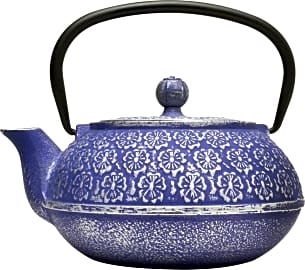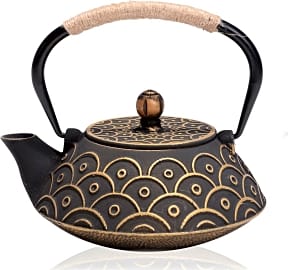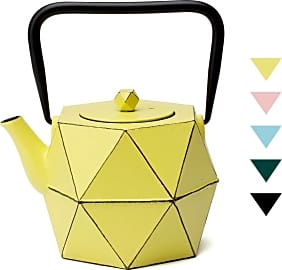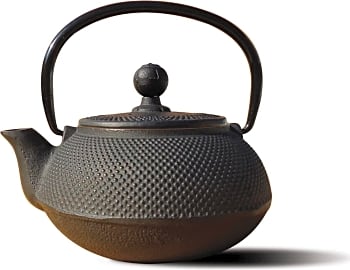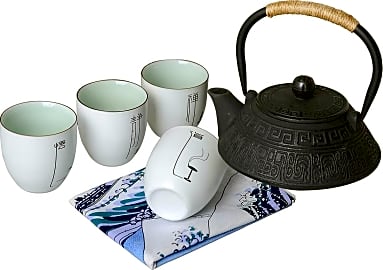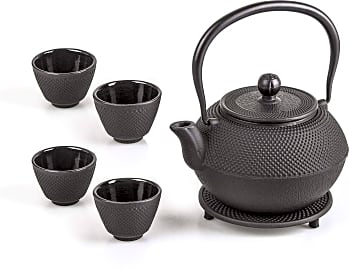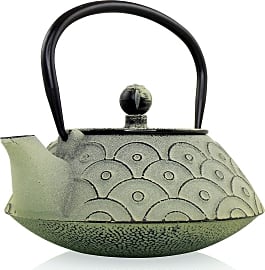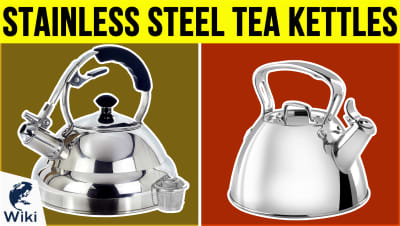The 10 Best Cast Iron Teapots

This wiki has been updated 36 times since it was first published in February of 2016. Travel to Japan, China, or England and you will see that serving tea is as much a ceremony as a chance for refreshment. These cast iron teapots will lend a touch of elegance to your kitchen and let you savor their brewed contents while admiring their beauty. Given their durable metal construction and protective enamel interiors, they're sure to last for years to come. When users buy our independently chosen editorial selections, we may earn commissions to help fund the Wiki.
Editor's Notes
March 24, 2020:
Designed to hold heat in well, cast iron teapots can trace their roots back to the Japanese iron kettle called a tetsubin that dates back to the 17th century. The ones in our selection come in an array of intriguing designs, and even those in neutral and subdued colors often boast interesting details, like the nail head design of the Kendal 4 Piece that symbolizes strength and beauty in the Japanese culture; or the M.V. Trading 27 Ounce, which is adorned with dragonflies, which symbolize joy, happiness, and strength. The Jueqi Japanese Tetsubin boats a striking design with gold-toned fish heads covering an otherwise black exterior.
A newly added model with an intriguing design of its own is the Toptier Diamond, which sports a multifaceted exterior made up two rows of triangles. You can choose from among colors like cheery yellow, retro avocado, pleasant pink, forest green, and more. It’s easy to hold and to pour from, thanks to its ergonomic, fold-down handle and short spout. It comes in an attractive box that makes it a nice housewarming or birthday gift for a tea-lover in your life.
The Old Dutch Sapporo also comes on board today, to replace the Old Dutch Kamakura, which is no longer available. It’s elegant, understated black design will match any kitchen décor, and its enamel interior both preserves the taste of your tea and makes it easy to clean. It’s sold in four similar designs, each of which offers a different capacity between 11 and 101 ounces.
Any fan of French cast iron cookware will certainly appreciate the newly added Staub Round Kettle, which is covered in a beautiful glaze and comes in your choice of red, blue, or gray. Its elegant design makes it great for stovetop-to-table use. Unlike many, this one is safe for electric, gas, and induction cooktops – and it’s oven-safe up to 500 degrees Fahrenheit if, for any reason, you wish to bake with it. It’s dishwasher safe and, unlike many cast iron products, does not need seasoning. With all of its cooking (and baking) capabilities, the metal handles can get very hot, so be sure to cover them with a potholder before attempting to lift it up.
If you’d actually prefer the durability and light weight of a stainless steel model, see our carefully curated list of best stainless steel tea kettles, which are also compatible with a variety of burner types.
Special Honors
Bloomsbury Market Brideshead Tea Set Inspired by Japanese cherry blossom trees, this stunning cast iron set can serve five, and each cup has its own unique color. Its designed in Japan and made in an earthenware factory in China with quality porcelain that’s been fired at a high temperature to maximize its strength. This makes it resistant to cracks, stains, and scratches. All pieces are dishwasher and microwave safe, including the teapot, as long as the handle and metal strainer are removed prior. wayfair.com
Which Cast Iron Teapot Is Right For You?
Many boast decorative handles that complement the design of the pot, and some even align with certain styles of tea drinking, especially that of the far east.
If you’re in the market for a teapot, there’s a good chance that you’ve been exposed to a litany of different styles. Classic porcelain or stainless steel are fine, but the one feels too grandmotherly, and the other too clinical. When it comes down to it, there’s nothing that can quite match the ease of maintenance, heat retention, and aesthetic quality of a cast iron teapot.
Of course, realizing you want a cast iron teapot still leaves a tremendous amount of options before you, and there are certain features you can look out for to make sure that you get the most possible use out of your selection, and that it gives you the utmost pleasure.
Since all the teapots on our list are made from the same material, there isn't’ much to say about how they will or will not affect the flavor of your tea. Most will perform to about the same standards here. But presentation, they say, has a heck of a lot to do with our experience of food and drink, and in this way, the teapot you choose can make a big difference.
That’s because cast iron teapots are traditionally ornate. They include images and patterns wrought into the material itself. Many boast decorative handles that complement the design of the pot, and some even align with certain styles of tea drinking, especially that of the far east. With that in mind, make sure you pick a pot that complements your personal aesthetic, as well as the kind of tea you drink the most.
You’ll also notice that there are a number of cast iron pots on the market that have infusion systems built in. These allow you to steep loose tea directly inside the pot without displacing very much water, so there’s still plenty of tea to go around. Not everyone cares for this kind of brewing, but if you prefer loose tea to bags and you don’t already have a tea ball, this can streamline your brewing process nicely.
One last thing to consider is whether or not the teapot you have your eye on comes with a set of cups. Some models out there come with cups that match the pot, creating a very pleasing set for your tea drinking. Others have cups available, but that are sold separately. Still others are stand alone teapots without cups of their own, and you’ll either have to hunt something down to complement them, or get creative in the design of your set.
How To Care For Your Cast Iron Teapot
If you own any cast iron cookware, you know that the maintenance process is a little different than that of other metal or nonstick pots and pans. In the case of cookware, you’ll find the regimen to be a little more time consuming than it is for teapots, which are comparably easy to care for. With just a little bit of attention, your cast iron teapot should last you for a great many years.
In the case of cookware, you’ll find the regimen to be a little more time consuming than it is for teapots, which are comparably easy to care for.
When you clean a cast iron teapot, as when you clean cast iron pans, it’s best not to use any soap. You can get away with it if you absolutely need it for your cookware, as long as it’s a small amount of very gentle detergent, but teapots are a little more temperamental in the presence of soaps. Fortunately, they’re designed to contain boiling water, which should go a long way toward sterilizing the inside of the pot. After you use your teapot, simply wipe it thoroughly with warm water and invert it to let it dry. If your pot came with an infuser, you can likely clean this with soap and water, but be sure to refer to your pot’s instructions just to be safe.
Over time, you may notice a certain flavor entering the tea from your cast iron, and this is both natural and desirable, especially if you only prefer one or two types of tea, as their flavor profiles will become more complex over the years. You may also notice signs of rust if the pot is left wet for too long, if your climate is particularly humid, or for other reasons. The good news here is that any rust in a cast iron teapot is harmless. In fact, many Japanese artisans carefully cultivate this rust to impart more complex flavors to their tea. If it freaks you out, though, you can wet the area and scrub it with a mild brush, then brew a strong batch of tea to be discarded. The tannic acids in the tea should help seal off the area and prevent any additional rust from forming.
On The Origins Of Tea
It’s hard to pinpoint exactly when and where tea was first consumed. It seems like such an integral part of our society that it would be easy to assume it had been around since prehistoric times, like some forms of alcohol or bread. But tea as we know it is a relatively recent phenomenon, at least to the bulk of the western world, and even eastern teas don’t provide us with any hard evidence of their consumption until around the 2nd century B.C.E.
It’s hard to pinpoint exactly when and where tea was first consumed.
Legend tells a different tale, however, one that reaches back a couple thousand more years, at least. In one telling, the Chinese emperor sat in his garden boiling some water in accordance with a writ decreeing the water toxic unless boiled. As the water heated up, some leaves from a nearby tree blew into the pot and infused the water with their flavors, colors, and other properties. The emperor drank, and tea was born.
Another legend comes to us from the Chan Buddhist tradition. In it, the religion’s founder accidentally fell asleep during a nine-year-long meditation, and when he woke up, he cut off his own eyelids to prevent it from happening again. It is said that the spot where he threw his eyelids to the ground is where the first tea bush sprung forth from the earth.
Wherever the stuff came from, and whoever drank it first we may never know for sure. What we can say with certainty is that the energizing, medicating, and social benefits of tea are undeniable.


